NutmegGraters.Com

Investigation Profile # 5. :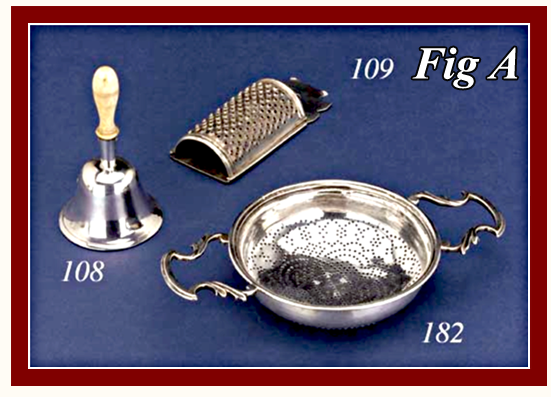
Nutmeg graters bearing problematic maker's marks attributed to the silversmith T. Fletcher of Philadelphia began appearing for sale about 2000. The spurious nature of these maker's marks was retrospectively identified after it was later discovered that an international known auction company, in 2000, had advertised a silver nutmeg grater (Fig A) described as "Lot No: 109 – A George III Nutmeg Grater APPARENTLY UNMARKED, Circa 1770, the shaped rectangular body with two slots for the curved metal grater, the back engraved with a crest - 10.2 cm. See illustration p.24" which sold for $736.00; however three years later in 2003, this same silver nutmeg grater (Fig A2) reappeared, then bearing a T. Fletcher maker's mark, prominently featured. This finding drew the maker's mark into question.
Investigation Profile #5 examines three silver nutmeg graters, each bearing identical but spurious T. Fletcher maker's marks. As shown below, these marks differ when compared to confirmed examples of this actual mark by the silversmith.
Thomas Fletcher (1787~1866) and Sidney Gardiner (1785 ~1827) were one of America's most prestigious silversmiths; their firm being first in Boston (1808~1811) and then in Philadelphia (1811~1842). Among the abundantly available company records, research and publications related to this firm, there is no currently known documentation supporting that Fletcher and Gardiner ever produced or sold silver nutmeg graters.
Form and Style:
Compiled for more than 30 years, the Klopfer Image File represents the documentation, study and image collection of more than 3000 silver nutmeg graters: [sources include but are not limited to ~ books and auction catalogs, on-line sales or auction archival resources, private and public collections.] This private file details nutmeg grater form, decorative styles, and marks. This data collection is useful when making comparative assessments. It is noted that the three nutmeg graters in question are in forms and styles created between Circa 1750 to 1835.
Three Nutmeg Graters Bearing Spurious Maker's Marks "T.FLETCHER":
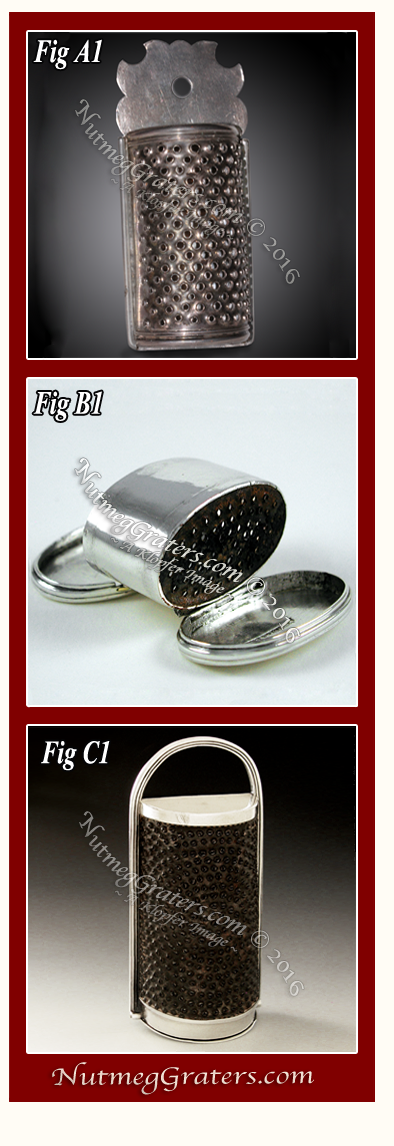
Purchase ~ Background Information:
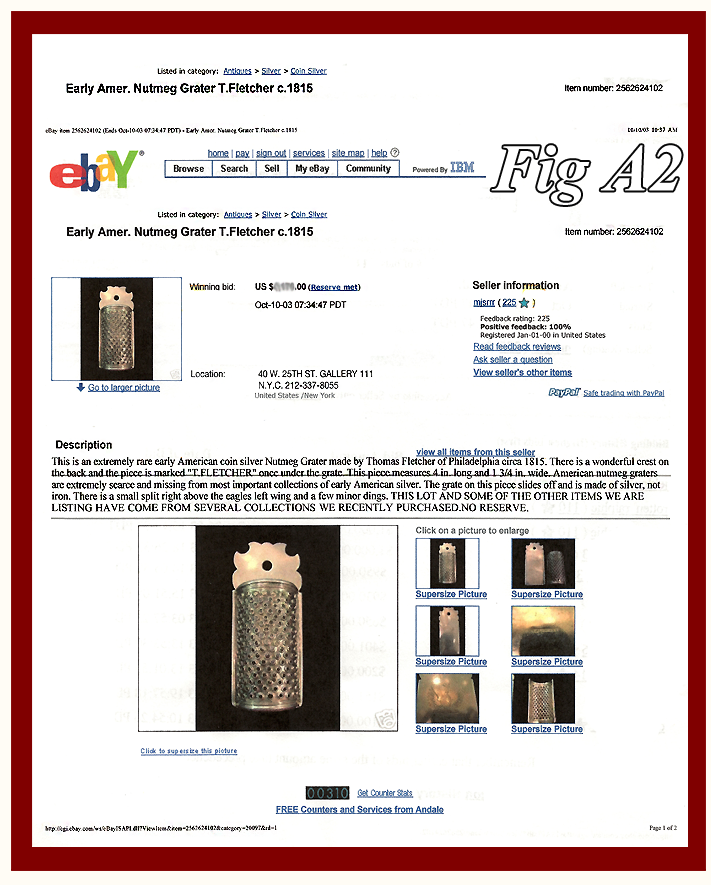 (Figs A1& A2 [and A~series]) In 2000, this silver kitchen / bottom grater with scalloped shaped crown was first sold in by an internationally known auction company, located in England. In 2003, it was sold as E-Bay Item # 2562624102 by Robert Lloyd, Inc, Manhattan Antique center, 40 W. 25th. Gallery 111, N.Y.C., NY 10022. The Lloyd ad described "This is an extremely rare early American coin silver Nutmeg Grater by Thomas Fletcher of Philadelphia circa 1815. There is a wonderful crest on the back and the piece is marked 'T.Fletcher' once under the grate. This piece measures 4 in. long and 1 ¾ in. wide. American nutmeg graters are extremely scarce and missing from most important collections of early American silver. The grate on this piece slides off and is made of silver, not iron. There is a small split right above the eagles left wing and a few minor dings. THIS LOT AND SOME OF THE OTHER ITEMS WE ARE LISTING HAVE COME FROM SEVERAL COLLECTIONS WE RECENTLY PURCHASED." No specific provenance was made available. Also noteworthy, the usual companion PHILA. mark that regularly accompanies the T.FLETCHER maker's mark was absent.
(Figs A1& A2 [and A~series]) In 2000, this silver kitchen / bottom grater with scalloped shaped crown was first sold in by an internationally known auction company, located in England. In 2003, it was sold as E-Bay Item # 2562624102 by Robert Lloyd, Inc, Manhattan Antique center, 40 W. 25th. Gallery 111, N.Y.C., NY 10022. The Lloyd ad described "This is an extremely rare early American coin silver Nutmeg Grater by Thomas Fletcher of Philadelphia circa 1815. There is a wonderful crest on the back and the piece is marked 'T.Fletcher' once under the grate. This piece measures 4 in. long and 1 ¾ in. wide. American nutmeg graters are extremely scarce and missing from most important collections of early American silver. The grate on this piece slides off and is made of silver, not iron. There is a small split right above the eagles left wing and a few minor dings. THIS LOT AND SOME OF THE OTHER ITEMS WE ARE LISTING HAVE COME FROM SEVERAL COLLECTIONS WE RECENTLY PURCHASED." No specific provenance was made available. Also noteworthy, the usual companion PHILA. mark that regularly accompanies the T.FLETCHER maker's mark was absent.
(Fig B1 [and B ~ series]) This oval form nutmeg grater with hinged top and bottom covers was purchased from Robert Lloyd Inc of Fine Antique Silver, P. O. Box 185, Albertson, NY 11507 (A.K.A.: Manhattan Antique Center, New York 10022) in 2000. It was listed as "1 Silver Nutmeg Grater By Thomas Fletcher" and was described as an item that "came from a very important Long Island private estate" sold exclusively to Mr. Lloyd.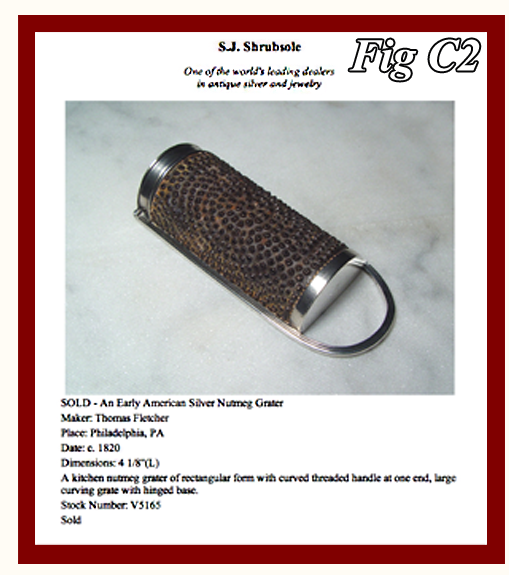 No specific provenance was made available. And like the first example, the usual companion PHILA. mark that regularly accompanies the T.FLETCHER maker's mark was absent.
No specific provenance was made available. And like the first example, the usual companion PHILA. mark that regularly accompanies the T.FLETCHER maker's mark was absent.
(Fig C1 & C2 [and C ~ series]) This silver kitchen / bottom grater was purchased from S. J. Shrubsole, 104 East 57 Street, New York, NY 10022 in 2009. It was described as: "An Early American Silver Nutmeg Grater; Maker: Thomas Fletcher; Place: Philadelphia, PA; Date: c. 1820; Dimensions: 4 ¹⁄₈" (L); A kitchen nutmeg grater of rectangular form with curved threaded handle at one end, large curving grate with hinged base." As seen with prior examples, no provenance was made available and the usual companion PHILA. mark was absent from the piece. Concluding investigation, it was returned for a full refund at which time Shrubsole disclosed that the prior seller was Robert Lloyd, Inc, Manhattan Antique center, 40 W. 25th. Gallery 111, N.Y.C., NY 10022.
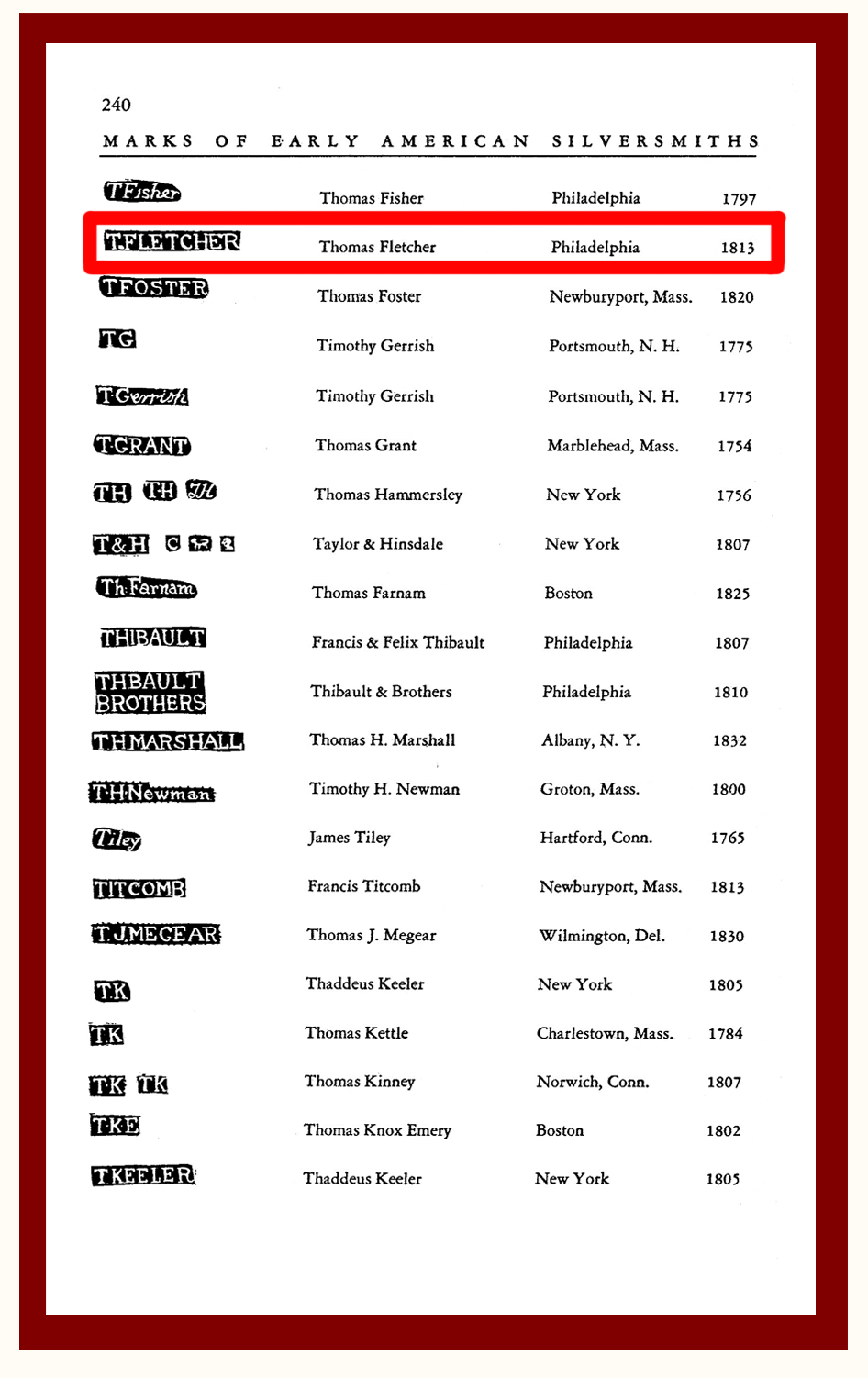 Review of the Literature:
Review of the Literature:
Recent scholarly research published by Donald Fennimore & Ann Wagner, and similarly reported by other modern historians, factually document just when Thomas Fletcher used both the PHILA. and T.FLETCHER (within rectangles) maker's marks. Fennimore and Wagner state: "Two marks used by Thomas Fletcher consisting of (a) T. FLETCHER and (b) PHILA., each in a rectangle. No dated silver has been found bearing mark (a), although it is on the United Bowmen's bowl, which is known to date before 1834. It was probably used from about 1830 to 1842. The mark may also have appeared on silver sold by Fletcher during the 1840s and 1850s after his manufactory was closed." [Donald Fennimore & Ann Wagner, A Silversmiths to the Nation, Thomas Fletcher and Sidney Gardiner 1808-1842, Antique Collectors' Club, Winterthur Museum, 2008, Page 268]. Importantly, the marks were created by using two separate name~stamp, hand~punch die tools, that were consistently used in partnership [see below (Fig D)]:
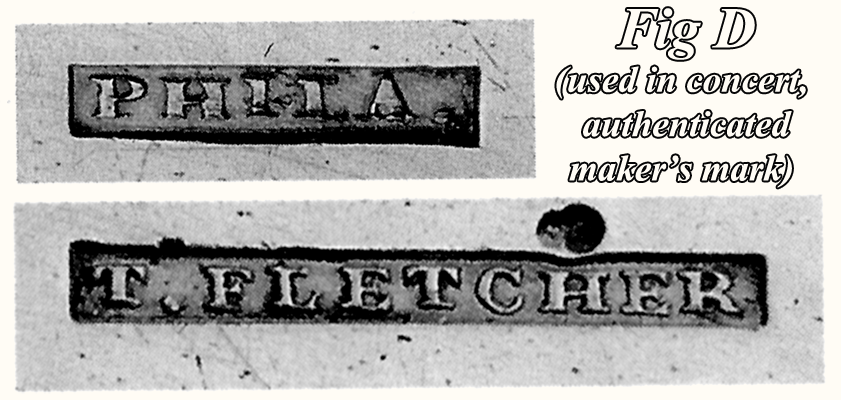
The earlier book, American Silversmiths and Their Marks, by Stephen G. C. Ensko (1948 {Dover Publication ~1983} Page 240 [See page to the right] ), erroneously misattributed information regarding the T.FLETCHER (within a rectangle) maker's mark by inaccurately stating the company used the T.FLETCHER mark in 1813; the correct dates being Circa 1830 to 1842 "possibly to 1850." The Ensko's designations appear unsupported by data. Further in error, Ensko makes no indication that the separate PHILA. mark was consistently use in concert with the T.FLETCHER mark.
An Investigative Portfolio:
The following six investigative analysis procedures were used to assess three nutmeg graters bearing suspect T.FLETCHER maker's marks:
(I). Punch Patter Analysis Identifies A Kitchen Grater (Fig A-series) As The Same Item Pre- and Post- Application Of A Spurious Maker's Mark:
A Punch Pattern Analysis is useful to identify that the "UNMARKED" Kitchen Grater for Nutmeg (Figs A & A3) auctioned in South Kensington, England on November 21, 2000 is the same item sold later, on October 10, 2003 as E-Bay Item number : 2562624102, described as "Early Amer. Nutmeg Grater T.Fletcher c. 1815" (Figs A1, A2, & A4).
During the eighteenth and early nineteenth century, artisans freehandedly perforated a grater's rasping surface, resulting in a distinctive arrangement of in-line, or annular (ring-shaped) sets of rows. Being hand-punched, each grate surface displays a unique distribution pattern of its teeth. These perforation piercings are similar to the unique features found among fingerprints ~ No two hand-punched grate patterns are exactly identical, even when several nutmeg graters are created in the exact same form and by the same hand craftsperson. Each nutmeg grater's punch work is unique to that specimen and differs from all other examples.
Below, (Fig A3) is taken from the original auction image of the "UNMARKED" grater pictured in 2000; (Fig A4) is a current image of the grater which now bears a "T.FLETCHER" maker mark. Under visual examination, the distribution of punched holes and imprecise patterning of perforation across the grate surfaces are an exact match. To highlight these findings, (Figs A5~7) show enlarged details of these punch work patterns.
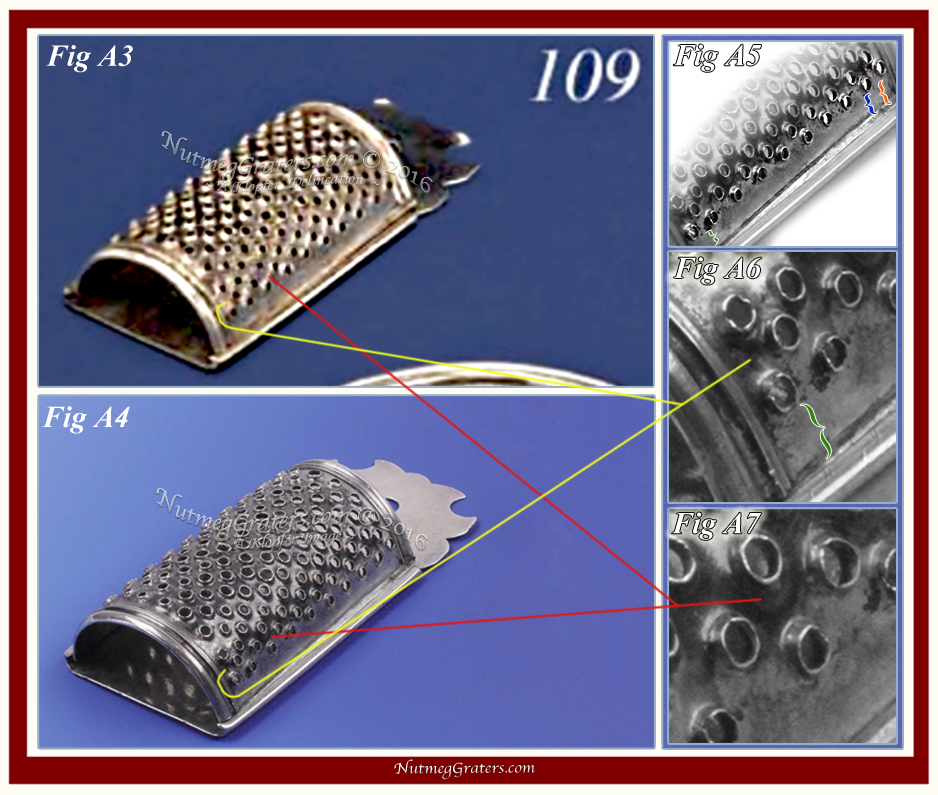
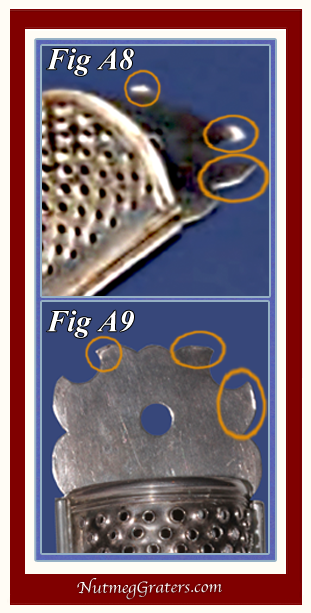
As seen in (Fig A5), notice with both images of this nutmeg grater, the row's spacing from the peripheral edge is wider at the top [indicated using orange and blue parenthesis marks], and narrows toward the bottom [indicated with the green parenthesis mark]. Notice adjacent to the orange parenthesis: this punch is unevenly out of alignment from the rest of the edge row of punch work; it displays a disproportionately wider spacing away from the perimeter edge.
With (Fig A6), compare that there is identical arrangement in spacing of 5 punch holes (teeth) [location indicated with yellow line to close-up image (Fig A6).] With (Fig A7), compare that there is identical arrangement in spacing, being 4 punch holes (teeth) [location indicated with red line to close-up image (Fig A7).] These distinctive patterns of teeth are unique to this grater.
Although to the casual eye, there may seem an overall appearance of symmetry in the rows, as demonstrated here [the non-alignment in punch work; the imprecise patterning in perforations across the grate surfaces; etc] the punch patterns are an exact match, indicating that images are of the same nutmeg grater.
(II). Analyzing Distress Patterns Observed At The Tips Of The "Crown" Further Identifies The Kitchen Grater (Fig A- series) As The Same Item Pre- and Post- Application Of A Spurious Maker's Mark:
A second method indicating that the "UNMARKED" silver kitchen / bottom grater with scalloped shaped crown sold in 2000 at auction in South Kensington, England, is the same "T.FLETCHER" maker marked item as marketed on E-bay by Robert Lloyd in 2003; is to analyze distress patterns. Simply compare the pattern of imperfections (crumpled edges) at the tips of the "crown". Notice that reflective light captures the damaged area at the "crown" [highlighted within orange circles (Fig A8 and A9)], and clearly indicate areas of damage in the form of three crimped and dented edges at identical locations along the "crown's"extremities.
The precise patterning of imperfections is an exact match as shown when comparing (Fig A8 and A9), thus indicative that these are the same nutmeg grater.
MAKER MARK ANALYISIS ~
Slight variations are expected when comparing the same maker's mark as applied to different silver items. The best account for this is detailed in Marks of American Silversmiths in the Ineson-Bissell Collection, Louise Conway Belden, University Press of Virginia, 1980; "Identification of Marks", Pages 21-23. The factors to account for subtle differences between marks struck using the same die include (but are not limited to): silver composition, hardness and quality; "differences in reflect wear, dirt or photographic technique"; the direction of the strike force applied by the silversmith, the amount of strike force; die slippage or lateral movement during the strike, die wear, and/or re-strike (or bounce) of the die. To determine usage of the same die, compare features of spacing, proportions, overall layout, shaping, styling, and most importantly, the identification of unique die flaws and shaping features of lettering and characters.
[NOTE: Photographing a maker's mark: a Canon MP-E-65 mm lens allows for a super-macro image (extreme close-up) which shows exceptional detail when viewing an original image on a high definition monitor/screen. The detail in images using the Canon MP-E-65 lens captures a high resolution photograph in magnificent quality. For example, this lens captures the image of one third of the tip of a pencil point to yield a high resolution image as large as 40 inches by 40 inches (100 cm X 100 cm). When viewing images throughout this website, keep in mind that by reducing resolution required for an ink-jet printer (at 300 DPI), the image quality is lessoned to only satisfactory image quality, and for a website (at 72 DPI) the image quality details are significantly lessoned to fair or marginal qualities. The actual Direct Visual Comparison between "Marks" was conducted using the highest resolution images available.]
[NOTE: The following Images below can be seen enlarged { (Figs D1 & B2), (Figs D2 & B3), (Figs D3 &B4), (Figs A10, B6, C3) } ~ First, "right-click" directly on the image and then select "Open Image in New Tab".]
(III). Analyzing Marks ~ Direct Visual Comparison Of An Authenticated "Maker's Mark" Against A Spurious "Maker's Mark":
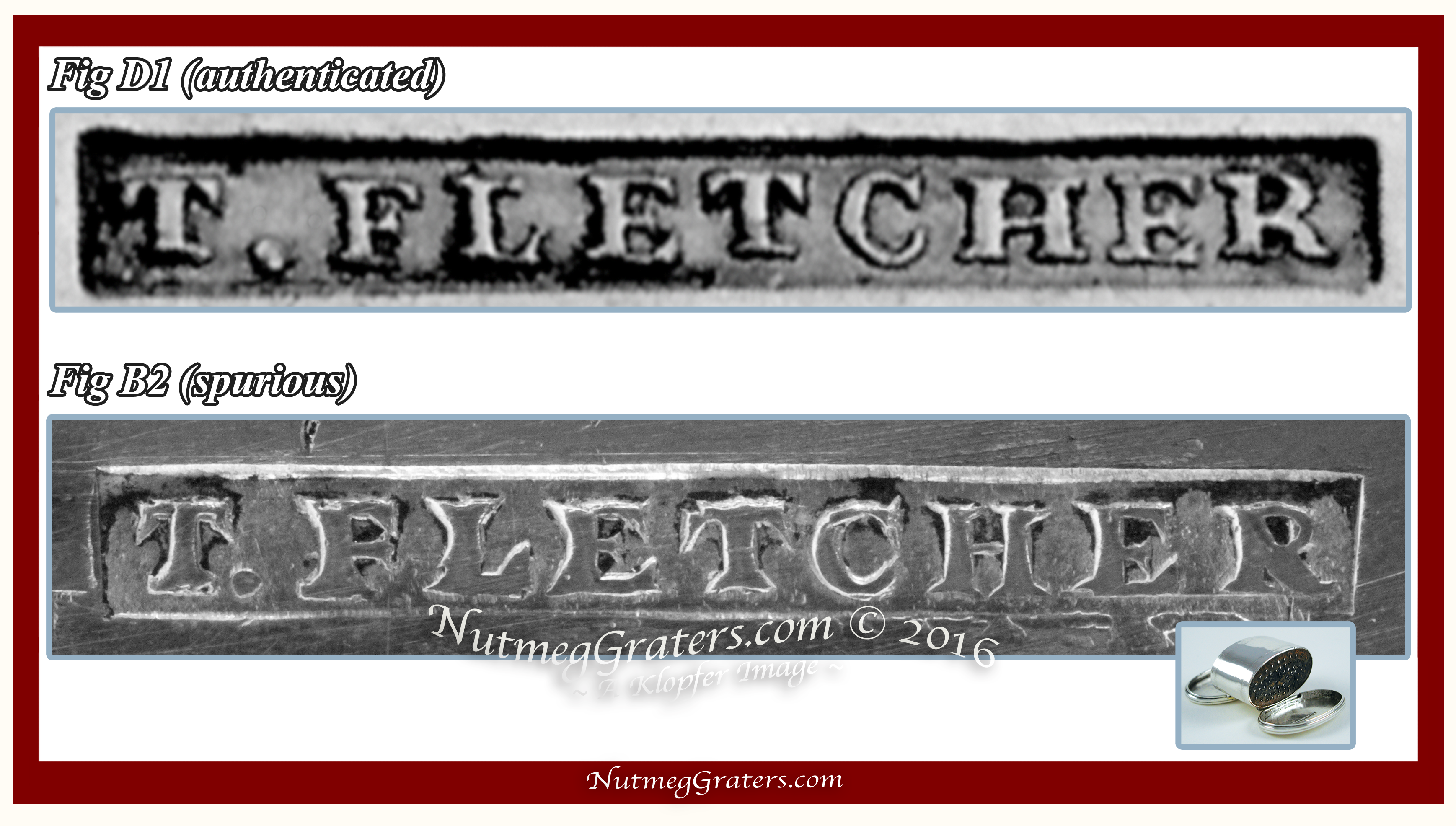
In this investigation, confirmed examples of the PHILA. and T.FLETCHER, Circa 1830-1842 maker's marks were acquired from multiple sources [including Winterthur's Decorative Arts Photographic Collection (DAPC), a collection containing abundant photographic images of American silver and their maker's marks; A Silversmiths to the Nation, Thomas Fletcher and Sidney Gardiner 1808-1842; Silver of the Americas, 1600-2000; Marks Of American Silversmith In The Ineson-Bissell Collection, and other on-line sources]. Provided with authenticated PHILA. and T.FLETCHER maker's mark images (Fig D1), a direct visual comparison was contrasted against the Canon MP-E-65 image of the maker's marks (Fig B2). [NOTE: Analysis Method IV (below) contrasts the maker's marks on the nutmeg graters (Figs A1, Fig B1, & Fig C1) under investigation, against each other.]
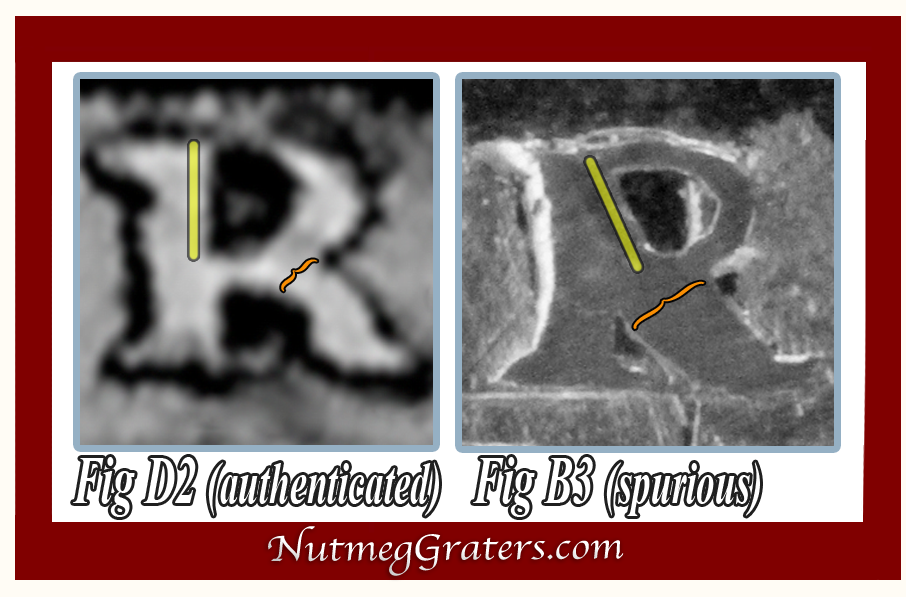 Using Direct Visual Comparison between high definition images of the spurious against an authenticated maker's mark, many significant differences become apparent. Comparing the genuine "T.FLETCHER" maker's mark (Fig D1) against the counterfeit maker's mark (Fig B2), their configurations are dissimilar. The maker's marks neither match in letter proportioning, nor in the quality of die-cutting refinement. The counterfeit maker's mark displays jagged edges along letter borders while appearing flat and shallow, a reflection of the die's poor craftsmanship.
Using Direct Visual Comparison between high definition images of the spurious against an authenticated maker's mark, many significant differences become apparent. Comparing the genuine "T.FLETCHER" maker's mark (Fig D1) against the counterfeit maker's mark (Fig B2), their configurations are dissimilar. The maker's marks neither match in letter proportioning, nor in the quality of die-cutting refinement. The counterfeit maker's mark displays jagged edges along letter borders while appearing flat and shallow, a reflection of the die's poor craftsmanship.
To further support this conclusion, three problematic features are specifically highlighted:
~ (Figs D2 & B3) compare the final 'R' characters. Notice that the counterfeit example (Fig B3) displays a misaligned "stem" [highlighted by a yellow line] causing the "counter" and "bowl" of the letter to misshapenly loop upwardly away from the "stem". Observe that the serifs [(Fig B3) top right "ear" and left "foot" ] are amateurish formations that poorly imitate a true serif. The letter formation and proportions do not coincide between these two marks; note by comparison , the right leg of the counterfeit 'R' is fat [as highlighted by the orange parenthesis] and rigidly non-curvaceous.
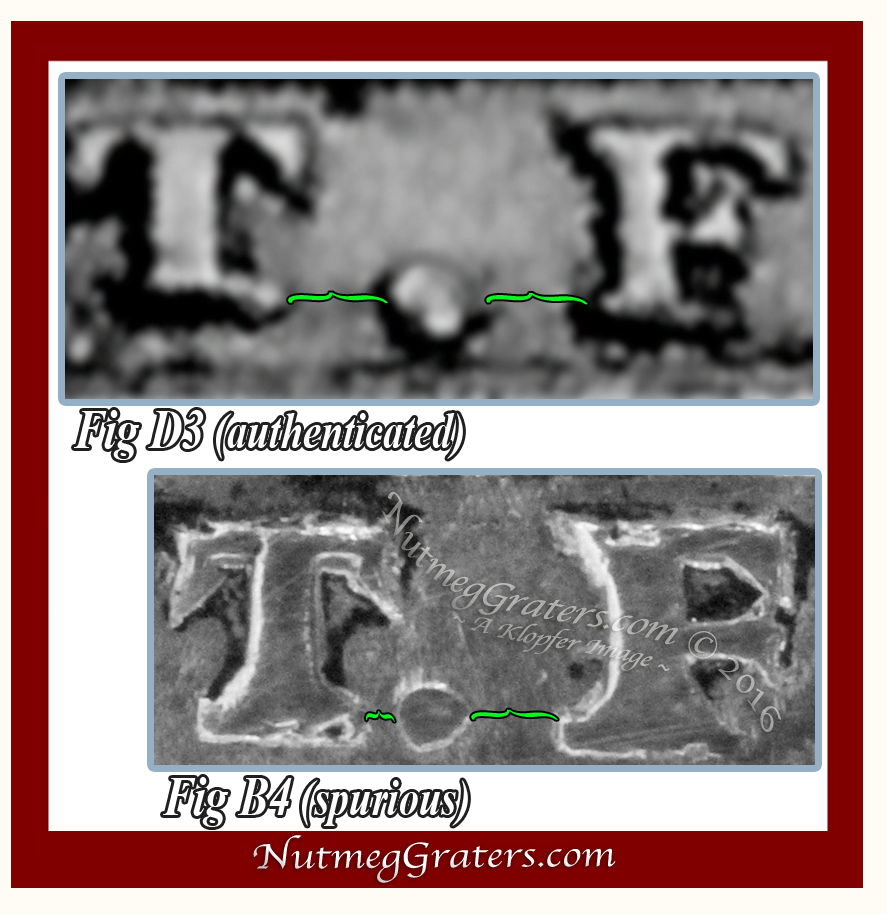 ~ (Figs D3 & B4) compare the positioning of the 'period' symbols to reveal another telltale counterfeiter's flaw. Observe [highlighted by the green parenthesis] that the 'period' with the authenticated maker's mark (Fig D3) is centered midpoint between the characters 'T . F'; whereas, with the counterfeit mark, (Fig B4) shows the 'period' positioned off-center, inaccurately close to the foot of the letter 'T'.
~ (Figs D3 & B4) compare the positioning of the 'period' symbols to reveal another telltale counterfeiter's flaw. Observe [highlighted by the green parenthesis] that the 'period' with the authenticated maker's mark (Fig D3) is centered midpoint between the characters 'T . F'; whereas, with the counterfeit mark, (Fig B4) shows the 'period' positioned off-center, inaccurately close to the foot of the letter 'T'.
~ (Figs D4 & B5) are useful to contrast the quality in shaping, sizing, and formation of 'letter characters' between the two 'T.FLETCHER' maker's marks. In every part of the authenticated maker's mark, notice that the serifs [projections extending from the main letter strokes] are precisely executed (D1~D4). With the counterfeited maker's mark (B2~B4), poor imitation of serifs are crudely cut, reduced to simple sharp-cornered, V-shaped gashes. Of special interest with the authentic mark, the letter characters 'T', 'R' and 'F' are beautifully styled, having a longer serif projected to the right side of the foot with a shorter serif from its left side ~ such superbly created, tiny features are the verification of work by a skilled early~nineteenth century artisan.
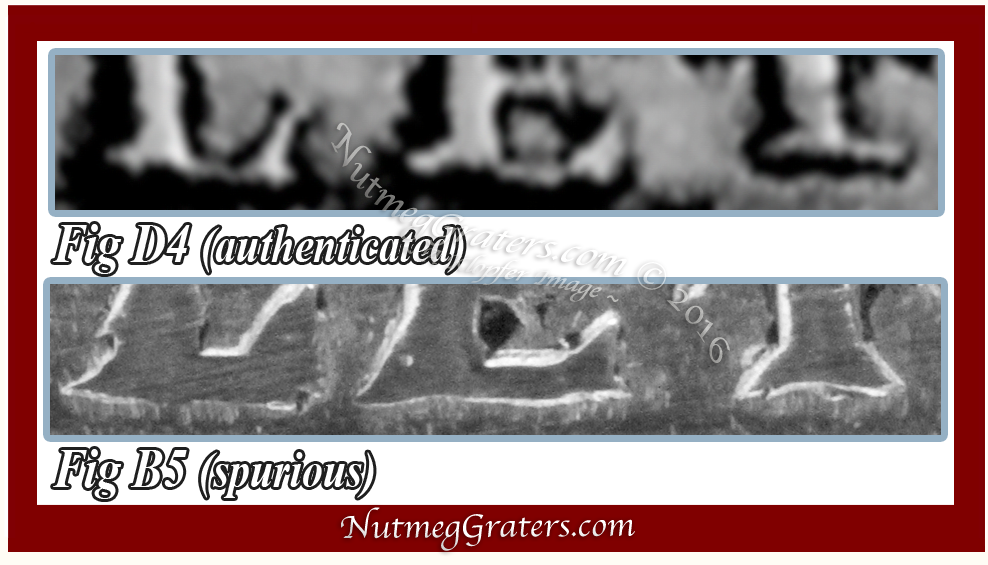
Finally, observe that the authenticated maker's mark (Fig D1) has a "square-shaped" and symmetrically formed right side edge (outline edge of the rectangle at right angles). However, with the spurious mark (Fig B2), as the edge descends from the top right corner of the mark, its outline misshapenly skews inwardly. [This is further examined in the next section (Feature 9a & 9b), where one surmises that a modern forger modeled this telltale error basing their forgery on the T.FLETCHER maker's mark depicted in Ensko's book, American Silversmiths and Their Marks, Page 240, 1948 {Dover Publication, 1983.}]
(IV). Analyzing Marks ~ Direct Visual Comparison Of Distinctive Die Flaw Features Seen With All Three Spurious "Marker's Marks" [nutmeg graters (Figs A, B, & C -series) under investigation]:
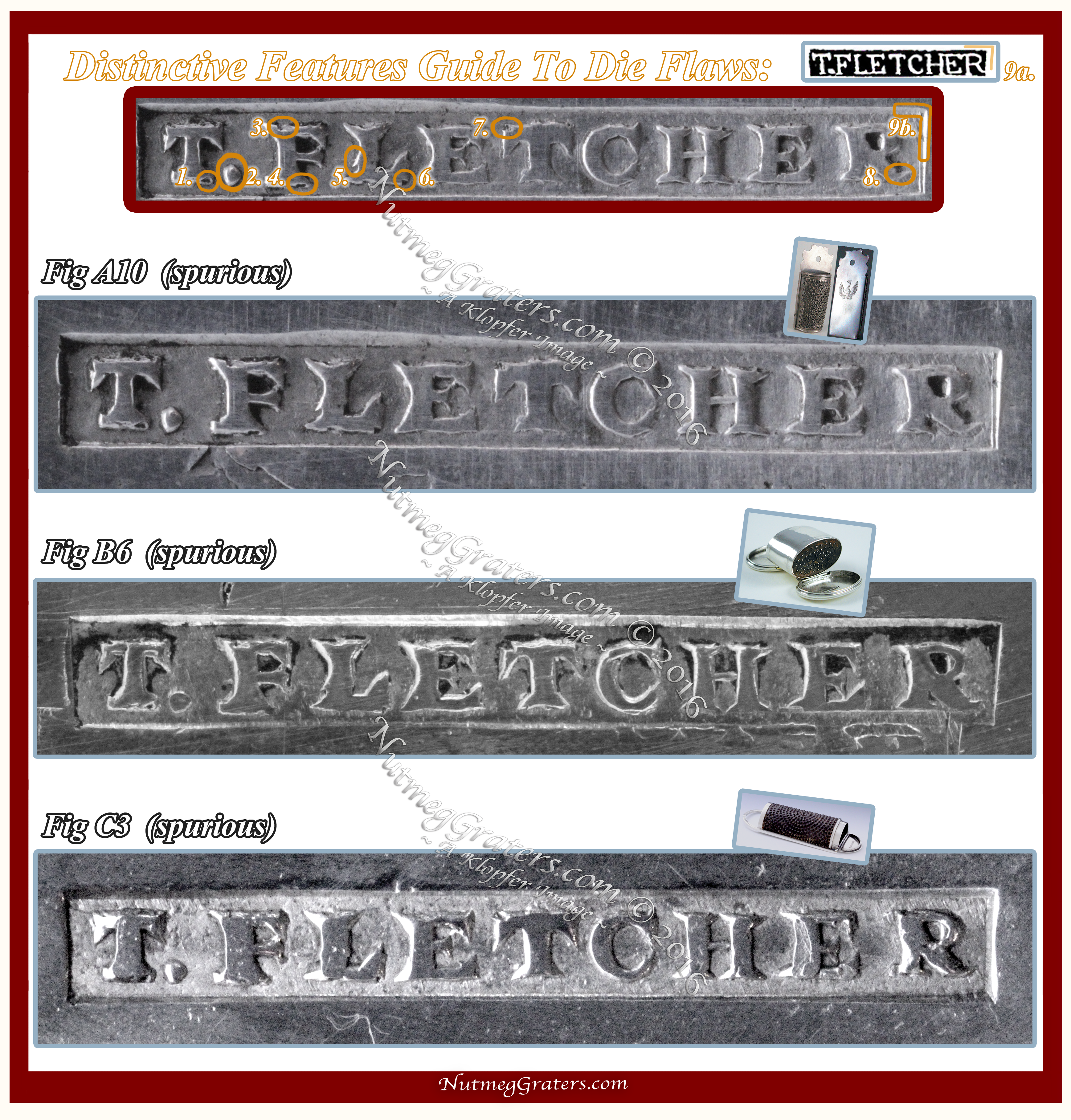
Notice that within the spurious maker's marks (Fig A10, Fig B6, Fig C3), all marks possess many identical distinctive die flaw features. Among these many flaws, a "Distinctive Feature Guide To Die Flaws" [Guide: located above (Fig A10)] was created to highlight [in orange] only nine of these examples.
~ Distinctive Die Flaws Features #1, #3, #4, #6, #7, #8: show unique die abrades that are common to each of the three spurious maker's mark.
~ Distinctive Die Flaws Features #2 : captures that the 'period' is problematically located at the foot of the letter 'T', [rather than centered: 'T . F'].
~ Distinctive Die Flaws Features #5 : highlights a unique spur from the left "stem" of letter 'L', as noted with all three marks in question.
~ Distinctive Die Flaws Features #9a : illustrates a flaw with the T.FLETCHER as published by Ensko (1948) [See: Review of Literature (above)].
The Ensko's image #9a incorrectly shows the margin at the top right corner of the mark as inwardly askewed .
~ Distinctive Die Flaws Features #9b : shows that the spurious maker's marks has a similar inwardly askew descending from the top right corner
[which is unlike the square corners seen with authenticated marks (Fig D1)].
There are additional Distinctive Feature Die Flaws among the spurious marks and viewers are free to search for them. These flaws clearly indicate that the spurious maker's marks (Figs A10, B6 and C3) were struck using the same counterfeiter's die.
(V). Analyzing Marks ~ Direct Visual Comparison ~ Absence of PHILA. Mark:
With authenticated Thomas Fletcher silver, the T.FLETCHER mark is consistently accompanied by a separate, companion PHILA. mark. Notice that the PHILA. mark, which was omitted from the Ensko book of marks, is also absent from the three nutmeg graters under study; this further suggests that a forger modeled their counterfeit mark based on Ensko's work.
(VI). Energy Dispersive X-ray Fluorescence Analysis (ED-XRF):
Dr. Jennifer L. Mass, Ph.D., of Scientific Analysis of Fine Art, LLC and Senior Scientist for Winterthur Museum, conducted x-ray fluorescent analysis on these nutmeg graters to measure the presents of its metal elements and the "fineness" of its silver content. "Among the second group, there are three examples marked 'T. Fletcher' " and "analysis was conducted to determine if the alloy of the pieces are period appropriate." Early "silver" [Ag] contained impurities such as "gold" [Au] and "lead" [Pb] which, after 1840 ~ 1860, were fully extracted during the refinement process of silver. Therefore, identifying these impurities indicates that an item's fabrication was prior to this time. Secondly, the degree of "fineness" (or, percentage of silver verses other metals) in antique silver varies among different countries and aides to support knowledge of its place of origin. "The "Kal" x-ray line is more representative of the bulk composition of and object, whereas the Lal x-ray line provides more information about the surface composition of an object. Comparison of the data from the two lines can give an indication of surface treatments such as pickling and plating." Multiple test spots were sampled on each of the three nutmeg graters as follow:
Grater (Fig A) - Kitchen /bottom grater with scalloped shaped crown marked "T. Fletcher". Dr. Mass stated: " This was originally sold as a George III grater that was unmarked, indicating that the Fletcher mark must be spurious." Five areas were sampled:
[Test Spot #1] (Reverse Side 1) [Test Spot # 2] (Reverse Side 2)
| ELEMENT | CONCENTRATION |
|---|---|
| Ag La1 | 82.8 wt. % |
| Cu Ka1 | 13.7 |
| Au La1 | 0.26 |
| Pb La1 | 0.51 |
| Ag Ka1 | 82.6 |
| ELEMENT | CONCENTRATION |
|---|---|
| Ag La1 | 86.1 wt. % |
| Cu Ka1 | 10.7 |
| Au La1 | 0.29 |
| Pb La1 | 0.53 |
| Ag Ka1 | 88.4 |
[Test Spot #3] (Inside Face at Mark) [Test Spot #4 ] (Side)
| ELEMENT | CONCENTRATION |
|---|---|
| Ag La1 | 90.2 wt. % |
| Cu Ka1 | 9.4 |
| Au La1 | 0.29 |
| Pb La1 | 0.40 |
| Ag Ka1 | 90.1 |
| ELEMENT | CONCENTRATION |
|---|---|
| Ag La1 | 88.1 wt. % |
| Cu Ka1 | 10.9 |
| Au La1 | 0.37 |
| Pb La1 | 0.34 |
| Ag Ka1 | 88.2 |
[Test Spot #5 ] (Side Edge)
| ELEMENT | CONCENTRATION |
|---|---|
| Ag La1 | 88.2 wt. % |
| Cu Ka1 | 10.6 |
| Au La1 | 0.30 |
| Pb La1 | 0.38 |
| Ag Ka1 | 88.64 |
Findings are based on copper [Cu], gold [Au] and lead [Pb] concentrations. Dr. Mass wrote: "Note that this object is below the English sterling standard, it is coin silver. This suggests an American or Continental origin for the piece, although the mark is spurious."
Grater (Fig B) - An Oval Pocket Grater marked "T. Fletcher". Three areas were sampled:
[Test Spot #1] (Top) [Test Spot # 2] (Underside)
| ELEMENT | CONCENTRATION |
|---|---|
| Ag La1 | 81.1 wt. % |
| Cu Ka1 | 16.3 |
| Au La1 | 0.06 |
| Pb La1 | 0.37 |
| Ag Ka1 | 83.2 |
| ELEMENT | CONCENTRATION |
|---|---|
| Ag La1 | 79.9 wt. % |
| Cu Ka1 | 16.7 |
| Au La1 | 0.06 |
| Pb La1 | 0.37 |
| Ag Ka1 | 82.8 |
[Test Spot #3 ] (Side Edge)
| ELEMENT | CONCENTRATION |
|---|---|
| Ag La1 | 76.0 wt. % |
| Cu Ka1 | 17.2 |
| Au La1 | 0.07 |
| Pb La1 | 0.40 |
| Ag Ka1 | 77.1 |
Findings are based on copper [Cu], gold [Au] and lead [Pb] concentrations. Dr. Mass wrote: "Note that the T. Fletcher oval grater is also coin silver, suggesting an American or Continental origin, although the mark appears to be spurious. The alloy is period, pre-dating electrolytic refining."
Grater (Fig C) - A Kitchen Nutmeg Grater of Rectangular Form with Curved Threaded Handle marked "T. Fletcher". Two areas were sampled:
[Test Spot #1] (Back Spot 1) [Test Spot # 2] (Back Spot 2)
| ELEMENT | CONCENTRATION |
|---|---|
| Ag La1 | 93.1 wt. % |
| Cu Ka1 | 06.1 |
| Au La1 | 0.09 |
| Pb La1 | 0.17 |
| Ag Ka1 | 83.7 |
| ELEMENT | CONCENTRATION |
|---|---|
| Ag La1 | 93.5 wt. % |
| Cu Ka1 | 06.2 |
| Au La1 | 0.09 |
| Pb La1 | 0.22 |
| Ag Ka1 | 93.5 |
Findings are based on copper [Cu], gold [Au] and lead [Pb] concentrations. Dr. Mass wrote: "Note that the composition of this piece exceeds the English sterling standard, suggesting that the piece could have an English origin. The trace gold and lead in this alloy indicate that it pre-dates electrolytic refining. Here too, however, the mark appears to be spurious."
ED-XRF Testing Summary and Conclusions(by Dr. Mass):
"The Fletcher-marked piece with the scalloped shaped crown was originally sold as a George III grater, but its alloy does not conform to the English sterling standard, but rather to coin silver. As a result, this may originally be a continental piece or early American piece with a spurious mark rather than having an English attribution. The oval Fletcher-marked piece is also coin silver, suggesting an American or Continental origin, although the mark appears to be spurious. The alloy pre-dates electrolytic refining. The third Fletcher-marked pice, a kitchen grater, has a composition that exceeds the English sterling standard, suggesting that the piece could have an English origin. The trace gold and lead in this alloy indicate that it pre-dates electrolytic refining. Here too, however, the mark appears to be spurious."
Investigation Outcome:
The three silver pocket nutmeg graters, in question, bear "spurious maker's marks" and thus, are falsely attributed as the work of Thomas Fletcher from Philadelphia, Pennsylvania, USA (working: 1808 to 1842 | with similar authenticated maker's mark investigated here that were used 1830 ~ 1842). A product study indicates no documentation to support that T. Fletcher, or Fletcher & Gardiner ever produced or marketed silver nutmeg graters. Not withstanding the counterfeited maker's mark, all three silver pocket nutmeg graters under investigation are genuine eighteenth century antiques, that were originally unmark.
The "fineness" quality with (Fig A1) the silver kitchen grater with scalloped crown and (Fig B1) the oval form nutmeg grater with hinged covers are typical of coin silver (atypical for English examples) and suggestive of American or Continental origins; (Fig C1) the kitchen nutmeg grater with curved threaded handle slightly exceeds the British standard which is characteristic of an English or French origin. Based on the Klopfer Image File, all three nutmeg grater forms and styles are known prior to the British Statutes of 1790, after which all silver nutmeg graters were required to be fully hallmarked. Being originally unmarked silver nutmeg graters, these three nutmeg graters under investigation remain the work by unknown and different silversmiths.
If you have a similarly marked item, we have interest to document and photograph pieces for further study.
[KLOPFER article © May 2016]